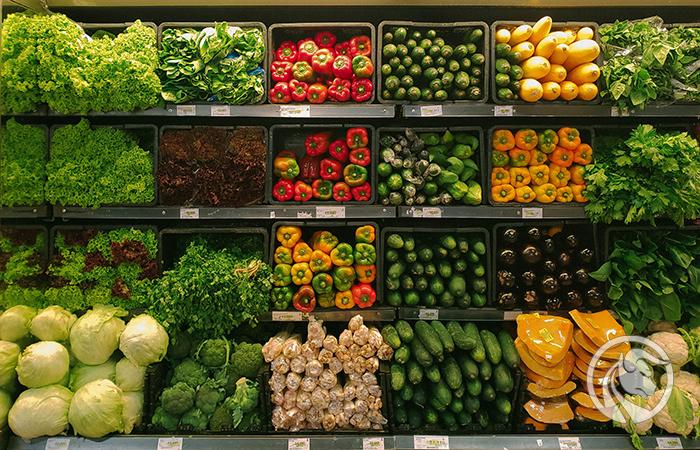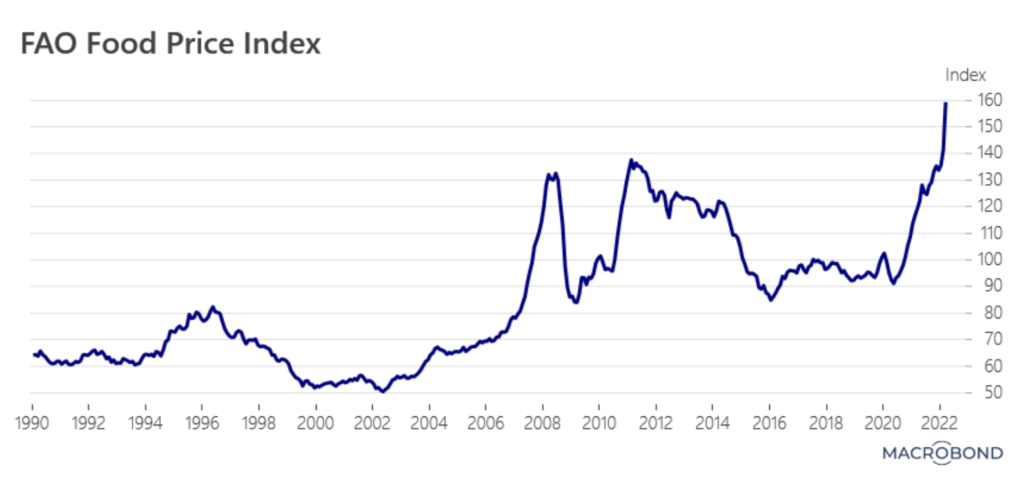Soaring food prices are hitting consumption in developed countries
Soaring food prices are undermining the purchasing power of households in developed countries. While food prices are at all-time highs, the lowest-income groups (15-20%) are most vulnerable. Even most higher-income households find it difficult to cope with the new situation and face difficult trade-offs (e.g. choosing between buying pasta or meat). The situation is expected to worsen in the near future. There is a high risk that consumption will drop significantly in the coming quarters. In some countries this trend is already visible (e.g. in France). This phenomenon should be carefully monitored as it increases the risk of stagflation and, in some cases, recession.
Food Price Index published by the Food and Agriculture Organization of the United Nations (FAO) increased by 12,6% between February and March. Currently, it is at the highest level since 1990 (since its creation). The previous record was broken in 2011 (137 against 159 today) - see the chart below. Both temporary and structural factors such as higher labor costs, ocean freight rates that have been rising steadily for more than a year, higher raw material costs, bad weather conditions (e.g. heatwave in India and Pakistan), export restrictions, increased demand for various food items (chicken and other meats in developed countries) and strong demand for biofuels which increased speculative demand.
Explanation: The FAO Food Price Index (FFPI) is a measure of the monthly change in international prices of a specific basket of agri-food commodities. It is the average of five commodity sub-indices, weighted by the average share in exports of each group in 2014-2016.
About the Author
 Christopher Dembik - French economist of Polish origin. He is global head of macroeconomic research at a Danish investment bank Saxo Bank (a subsidiary of the Chinese company Geely serving 860 HNW customers around the world). He is also an advisor to French parliamentarians and a member of the Polish think tank CASE, which took first place in the economic think tank in Central and Eastern Europe according to a report Global Go to Think Tank Index. As a global head of macroeconomic research, he supports branches, providing analysis of global monetary policy and macroeconomic developments to institutional and HNW clients in Europe and MENA. He is a regular commentator in international media (CNBC, Reuters, FT, BFM TV, France 2, etc.) and a speaker at international events (COP22, MENA Investment Congress, Paris Global Conference, etc.).
Christopher Dembik - French economist of Polish origin. He is global head of macroeconomic research at a Danish investment bank Saxo Bank (a subsidiary of the Chinese company Geely serving 860 HNW customers around the world). He is also an advisor to French parliamentarians and a member of the Polish think tank CASE, which took first place in the economic think tank in Central and Eastern Europe according to a report Global Go to Think Tank Index. As a global head of macroeconomic research, he supports branches, providing analysis of global monetary policy and macroeconomic developments to institutional and HNW clients in Europe and MENA. He is a regular commentator in international media (CNBC, Reuters, FT, BFM TV, France 2, etc.) and a speaker at international events (COP22, MENA Investment Congress, Paris Global Conference, etc.).
The situation is to be expected to worsen
The current state of affairs is going to worsen, at least in the short term. It is known how sensitive the emerging and developing markets are to food price fluctuations (32 African countries import approx. 90% of basic food products). This means greater political instability in these countries. A new phenomenon is that developed countries are also hard hit by soaring prices. Since the economic recovery, several developed countries have experienced significant wage increases (even in the euro area where wages have finally started to rise). However, this is not enough to combat the effects of higher inflation. In our opinion, the lowest-income population in developed countries (the lowest quintile of around 15-20% of households) will face a severe reduction in disposable income in the coming months.
Many food items have low price elasticity and demand for them is poorly responsive to price changes. However, this does not apply to all products. We talk about weak elasticity when a rise in prices does not cause consumption to fall (in most cases due to the fact that these products are considered essential). According to data from the US Department of Agriculture, the price elasticity of American households' demand for bread and cereals is 0,04 - when this value is much lower than 1,0, it means that the item does not respond to price changes. It is legitimate. Bread and cereals are often staple items on the shopping list of the poorest households. They also cannot be directly replaced with other products. According to the research results, only a large increase in the prices of basic articles (at a double-digit level) may lead to a decrease in consumption. The US Department of Agriculture estimates that a 25% increase in bread prices leads to a 1% decrease in consumption. However, some food products are flexible in price, such as meals eaten outside the home, juices, soft drinks, etc. According to the department mentioned above, a 10% increase in the price of non-alcoholic beverages reduces consumption by an average of 8-10%. The poorest households now face a choice: put pasta or fresh meat in the basket. It is logical. According to a study by the French Bureau of Statistics (INSEE), when cereal and pasta prices rise by an average of 1%, it causes a decrease in meat consumption by 0,23%. Basically, households are abandoning items that are perceived to be the most expensive or "luxurious" on the shopping list.
READ: How to invest in the food market [Guide]
Higher food prices will lead to a significant drop in consumption
In the current environment of prolonged high inflation, the consumption of staple foods with low price elasticity of demand is likely to remain stable in most developed countries. On the other hand, the consumption of other food products and unnecessary expenses (trips, electronics, hotels, etc.) will decrease. Consumption has already fallen significantly in several countries. In France, household consumption of goods fell by 2022% in March 1,3. in quantitative terms. This decrease is mainly explained by a decrease in food consumption (-2,5%). When analyzing the data in detail, it can be noticed that they concern only food products with low price elasticity of demand (sweets and sugar, eggs, cheese, etc.). This is cause for concern. In most developed countries, consumption is the main driver of economic growth. Its fall increases the risk of stagflation or, in some cases, recession (for example in the UK). Political turmoil is also to be expected. Where I am now (Saxo's Paris office), I would not be surprised if there were mass demonstrations after the summer break in France where people would take to the streets to protest against the high cost of living and food prices (remember that the 'yellow vest' movement started in 2018 was driven by rising fuel prices). It is certain that there is nothing to expect a repeat of the crazy twenties, contrary to what many specialists thought, when developed economies reopened after the pandemic in the spring of last year. The economic outlook may turn out to be gloomier.






















![Forex Club – Tax 9 – Settle tax on a foreign broker [Download the Application] Forex Club - Tax 9](https://forexclub.pl/wp-content/uploads/2024/02/Forex-Club-Podatek-9-184x120.jpg?v=1709046278)
![Trading View platform – solutions tailored to the needs of traders [Review] trading view review](https://forexclub.pl/wp-content/uploads/2024/03/trading-view-recenzja-184x120.jpg?v=1709558918)
![How to connect your FP Markets account to the Trading View platform [Guide] fp markets trading view](https://forexclub.pl/wp-content/uploads/2024/02/fp-markets-trading-view-184x120.jpg?v=1708677291)
![How to invest in ChatGPT and AI? Stocks and ETFs [Guide] how to invest in chatgpt and artificial intelligence](https://forexclub.pl/wp-content/uploads/2023/02/jak-inwestowac-w-chatgpt-i-sztuczna-inteligencje-184x120.jpg?v=1676364263)






![Izabela Górecka – “Success on the market depends not only on knowledge, but also on emotional stability” [Interview] Izabela Górecka - interview](https://forexclub.pl/wp-content/uploads/2024/04/Izabela-Gorecka-wywiad-184x120.jpg?v=1713870578)
![WeWork – the anatomy of the collapse of a company valued at $47 billion [WeWork, part II] wework bankruptcy story](https://forexclub.pl/wp-content/uploads/2024/04/wework-bankructwo-historia-184x120.jpg?v=1711729561)
![Adam Neumann – the man who screwed up Softbank [WeWork, part AND] adam neumann wework](https://forexclub.pl/wp-content/uploads/2024/04/adam-neumann-wework-184x120.jpg?v=1711728724)


![The most common mistakes of a beginner trader - Mr Yogi [VIDEO] Scalping - The most common mistakes of a beginner trader - VIDEO](https://forexclub.pl/wp-content/uploads/2024/03/Scalping-Najczestsze-bledy-poczatkujacego-tradera-VIDEO-184x120.jpg?v=1711601376)
![Learning patience: No position is also a position - Mr Yogi [VIDEO] Scalping - Learning patience - No position is also a position - VIDEO](https://forexclub.pl/wp-content/uploads/2024/03/Scalping-Nauka-cierpliwosci-Brak-pozycji-to-tez-pozycja-VIDEO-184x120.jpg?v=1710999249)
![When to exit a position and how to minimize losses - Mr Yogi [VIDEO] Scalping - When to exit a position and how to minimize losses - VIDEO](https://forexclub.pl/wp-content/uploads/2024/03/Scalping-Kiedy-wyjsc-z-pozycji-i-jak-minimalizowac-straty-VIDEO-184x120.jpg?v=1710336731)



















Leave a Response